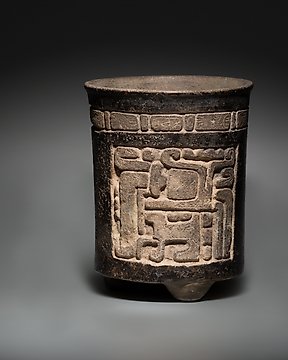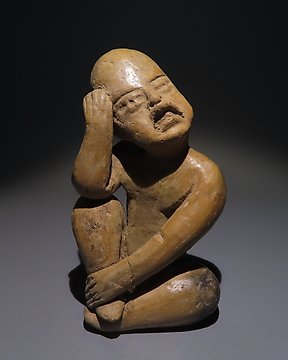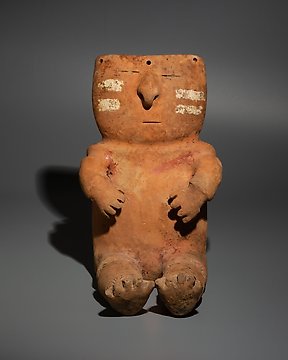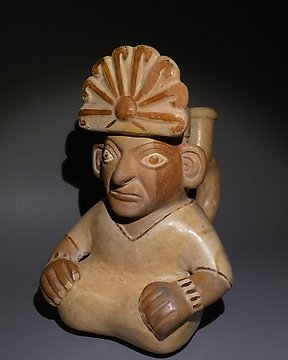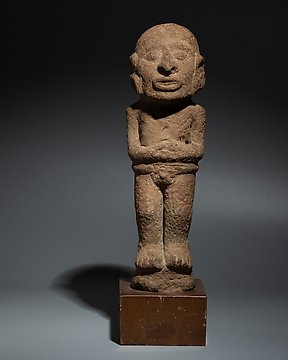El objeto decía estar en perfecto estado , intacto y en buena condición. Sin embargo estaba dañado y el silbato no funcionaba. Fue un engaño. Lamento la mala informacion
Ver traduzidoColima, oeste do México Terracota Embarcação em forma de lontra. 200 a.C. - 200 DC. Com licença de importação espanhola. 23 cm L.
N.º 85410119



Vessel in the shape of an otter
CULTURE: Colima, Western Mexico
PERIOD: 200 B.C. - 200 AD
MATERIAL: Terracotta
DIMENSIONS: 23 cm L.
PROVENANCE: Private collection of Isadore and Nancy Marderr, Philadelphia, USA. 1960-1970. With spanish import license.
CONDITION: Intact.
DESCRIPTION:
The Colima people lived in northwest Mexico, in a rugged, low-lying coastal region carved by valleys, each with its own ecology and a warm, humid climate.
Little is known about their modes of subsistence, as most of the information we have comes from artifacts from private collections and from the excavation of cemeteries, not residential sites, which usually provide this kind of information. We do know that they practiced irrigation farming, which allowed them to live in large groups in relatively independent villages and urban centers.
Colima ceramics display a wide variety of figures and shapes, but little variation in technique. Most pieces have a burnished red finish and some are decorated with orange or white incisions. Molded figures are common, especially of plants, animals (especially dogs) and seashells. Human representations typically feature dwarfs and hunchbacks more than others, and few female forms. Many of these figures have “coffee-bean” eyes and are dressed in finely detailed traditional attire. Little is known of Colima stonework; only a few pieces such as mace heads, small masks and figurines have been found. These people also practiced basketweaving and weaving, and used metallurgy to make objects such as needles, axes, rattles, nose rings and ear ornaments.
Little is known about the Colima’s social order, but shamans or priests may have occupied positions of social importance. The existence of figurines resembling warriors as well as prisoners with hands tied points to the ceremonial importance of war in this pre-Columbian society.
The vast majority of ceramic pieces that have been ascribed to this culture are grave goods found in the tombs of individuals of high social rank. The Colima buried their dead in family tombs up to 30 meters deep, some with multiple chambers. The bodies were accompanied by a wide variety of grave goods, including ceramic statuettes of armed men, which served as symbolic guardians. Ceramic sculptures of dogs were another common grave good, and were believed to be the emissaries of Xolotl, the god of death.
The history of the Colima people is not well known, but, like many Mesoamerican cultures, the Colima displayed some stylistic elements that links them with the ancient Olmecs.
Notes:
- The piece includes authenticity certificate.
- The piece includes Spanish Export License.
- The seller guarantees that he acquired this piece according to all national and international laws related to the ownership of cultural property. Provenance statement seen by Catawiki.
THE MINISTRY OF CULTURE FROM SPAIN ASKS ALL SELLERS FOR INVOICES, IMPORT LICENSES AND ALL THE DOCUMENTATION ABLE TO PROVE THE LEGALITY OF EACH ITEM BEFORE PROVIDING AN IMPORT OR EXPORT LICENSE.
Mais sobre o vendedor
Vessel in the shape of an otter
CULTURE: Colima, Western Mexico
PERIOD: 200 B.C. - 200 AD
MATERIAL: Terracotta
DIMENSIONS: 23 cm L.
PROVENANCE: Private collection of Isadore and Nancy Marderr, Philadelphia, USA. 1960-1970. With spanish import license.
CONDITION: Intact.
DESCRIPTION:
The Colima people lived in northwest Mexico, in a rugged, low-lying coastal region carved by valleys, each with its own ecology and a warm, humid climate.
Little is known about their modes of subsistence, as most of the information we have comes from artifacts from private collections and from the excavation of cemeteries, not residential sites, which usually provide this kind of information. We do know that they practiced irrigation farming, which allowed them to live in large groups in relatively independent villages and urban centers.
Colima ceramics display a wide variety of figures and shapes, but little variation in technique. Most pieces have a burnished red finish and some are decorated with orange or white incisions. Molded figures are common, especially of plants, animals (especially dogs) and seashells. Human representations typically feature dwarfs and hunchbacks more than others, and few female forms. Many of these figures have “coffee-bean” eyes and are dressed in finely detailed traditional attire. Little is known of Colima stonework; only a few pieces such as mace heads, small masks and figurines have been found. These people also practiced basketweaving and weaving, and used metallurgy to make objects such as needles, axes, rattles, nose rings and ear ornaments.
Little is known about the Colima’s social order, but shamans or priests may have occupied positions of social importance. The existence of figurines resembling warriors as well as prisoners with hands tied points to the ceremonial importance of war in this pre-Columbian society.
The vast majority of ceramic pieces that have been ascribed to this culture are grave goods found in the tombs of individuals of high social rank. The Colima buried their dead in family tombs up to 30 meters deep, some with multiple chambers. The bodies were accompanied by a wide variety of grave goods, including ceramic statuettes of armed men, which served as symbolic guardians. Ceramic sculptures of dogs were another common grave good, and were believed to be the emissaries of Xolotl, the god of death.
The history of the Colima people is not well known, but, like many Mesoamerican cultures, the Colima displayed some stylistic elements that links them with the ancient Olmecs.
Notes:
- The piece includes authenticity certificate.
- The piece includes Spanish Export License.
- The seller guarantees that he acquired this piece according to all national and international laws related to the ownership of cultural property. Provenance statement seen by Catawiki.
THE MINISTRY OF CULTURE FROM SPAIN ASKS ALL SELLERS FOR INVOICES, IMPORT LICENSES AND ALL THE DOCUMENTATION ABLE TO PROVE THE LEGALITY OF EACH ITEM BEFORE PROVIDING AN IMPORT OR EXPORT LICENSE.
Mais sobre o vendedor
- 752
- 7
- 1
Fast delivery, object fine. However, bad carrier: please never use again DHL express as they are "DHL slow": instead of coming to my address, they put it directly to a DHL Service Point/Locker.
Ver traduzidoTodo correcto
Ver traduzidoI am very happy with the ancient bronze horse. Excellent that it was delivered within a few days. My compliments to J.Bagot Arqueologia- Ancient Art, well done! Ron van Schaick
Ver traduzidoPerfect transaction and fantastic item. Thank you.
Ver traduzidoconforme rapide hope other thanks ++++
Ver traduzidoKülönleges eszköz, jó állapotban van, köszönöm a rendkívül gyors szállítást. Ajánlom az Eladót!
Ver traduzidofast delivery, good packaging
Ver traduzidoGood seller: fast shipment, good packing and a very nice object. Thank you!
Ver traduzidosuper 💯💯💯💯💯
Ver traduzidoIl pezzo è arrivato in condizioni perfette il pacco era protetto alla perfezione
Ver traduzidoBuenos días, señor. ¡Gracias por las precauciones de embalaje Tip / Top! Muy contento con mi compra. ¡Gracias!
Ver traduzidoPerfecto! :)
Ver traduzidoWunderbares Stück. Alles wie beschrieben. Hervorragender Kontakt.
Ver traduzidoExtremely rapid courrier service from Barcelona to Flanders, picture was nicely and carefully packaged. Muchas gracias!
Ver traduzidoVery fine specimen! Thanks.
Ver traduzidogoede foto's, goede omschrijving, goed verpakt en snel verzonden.
Ver traduzidomolto bello tutto ok
Ver traduzidoPezzo come da descrizione, davvero notevole. Venditore molto consigliato in quanto gentile e disponibile. spedizione molto veloce. Ottimo!
Ver traduzidoVenditore davvero ottimo e gentile. Merce come da descrizione, spedizione veloce. Ottimo l'avere certificato di autenticità.
Ver traduzidoUn 100 como empresa un 100 como envío . Empresa muy especial con mucha exquisitez en todos los productos y en personal . Muchas gracias
Ver traduzidoAll well! Thanks.
Ver traduzidoVery nice and fine cut little jewel! Well packed too! Thanks!
Ver traduzidonice piece and very fast shipping!
Ver traduzido- 752
- 7
- 1
El objeto decía estar en perfecto estado , intacto y en buena condición. Sin embargo estaba dañado y el silbato no funcionaba. Fue un engaño. Lamento la mala informacion
Ver traduzido


